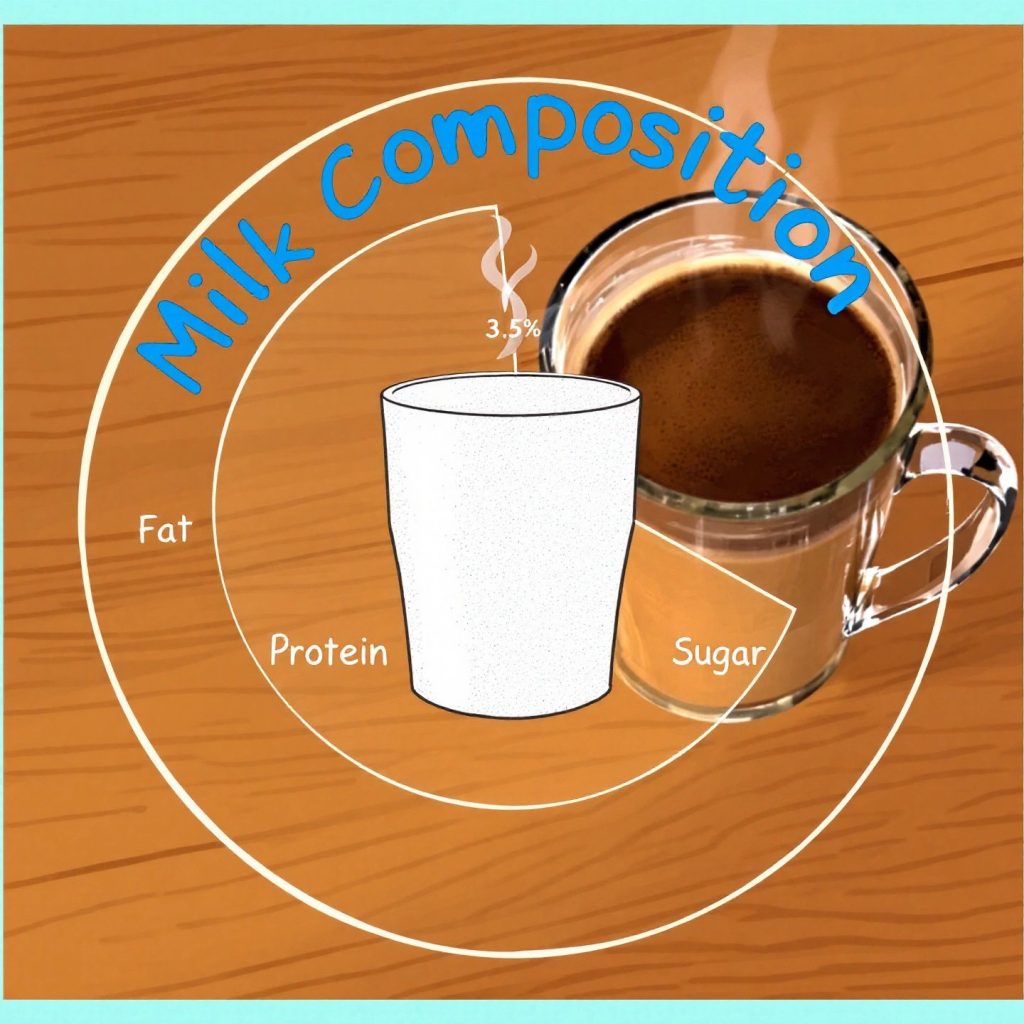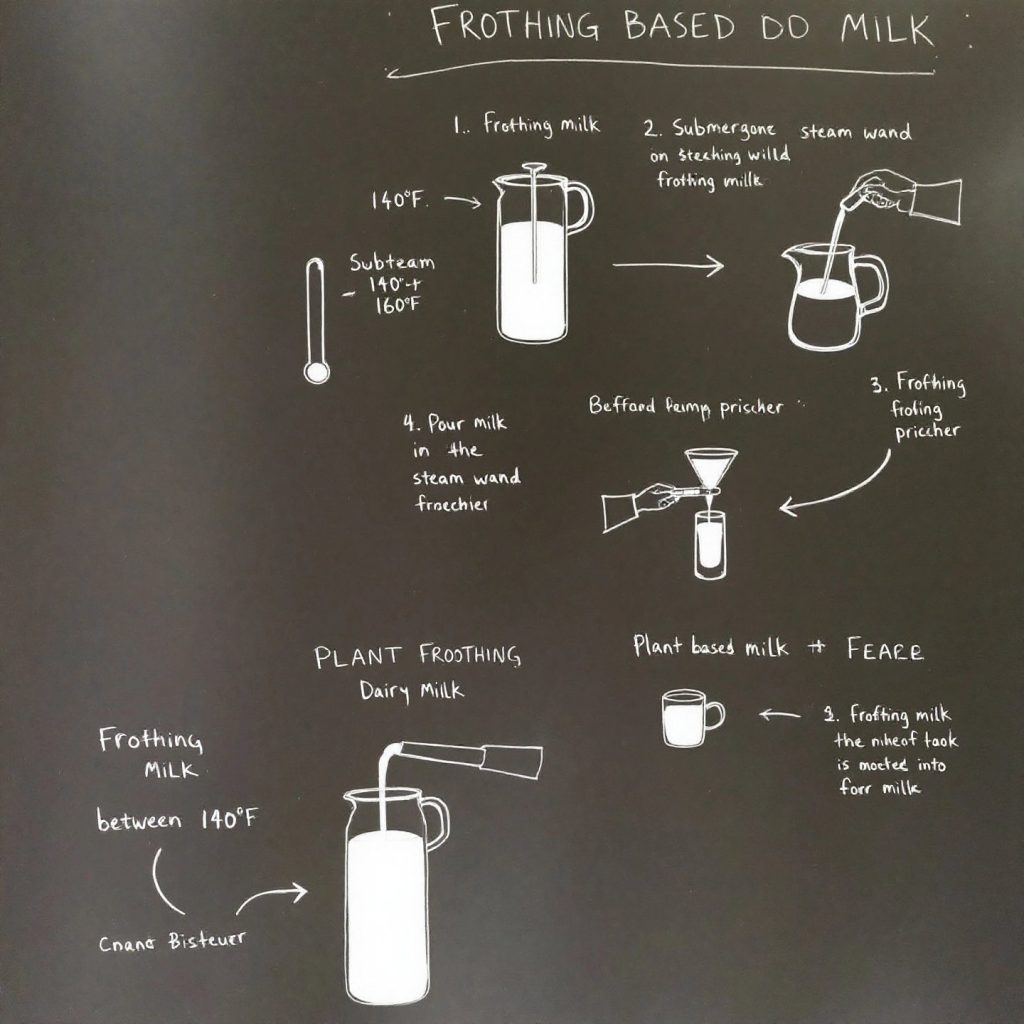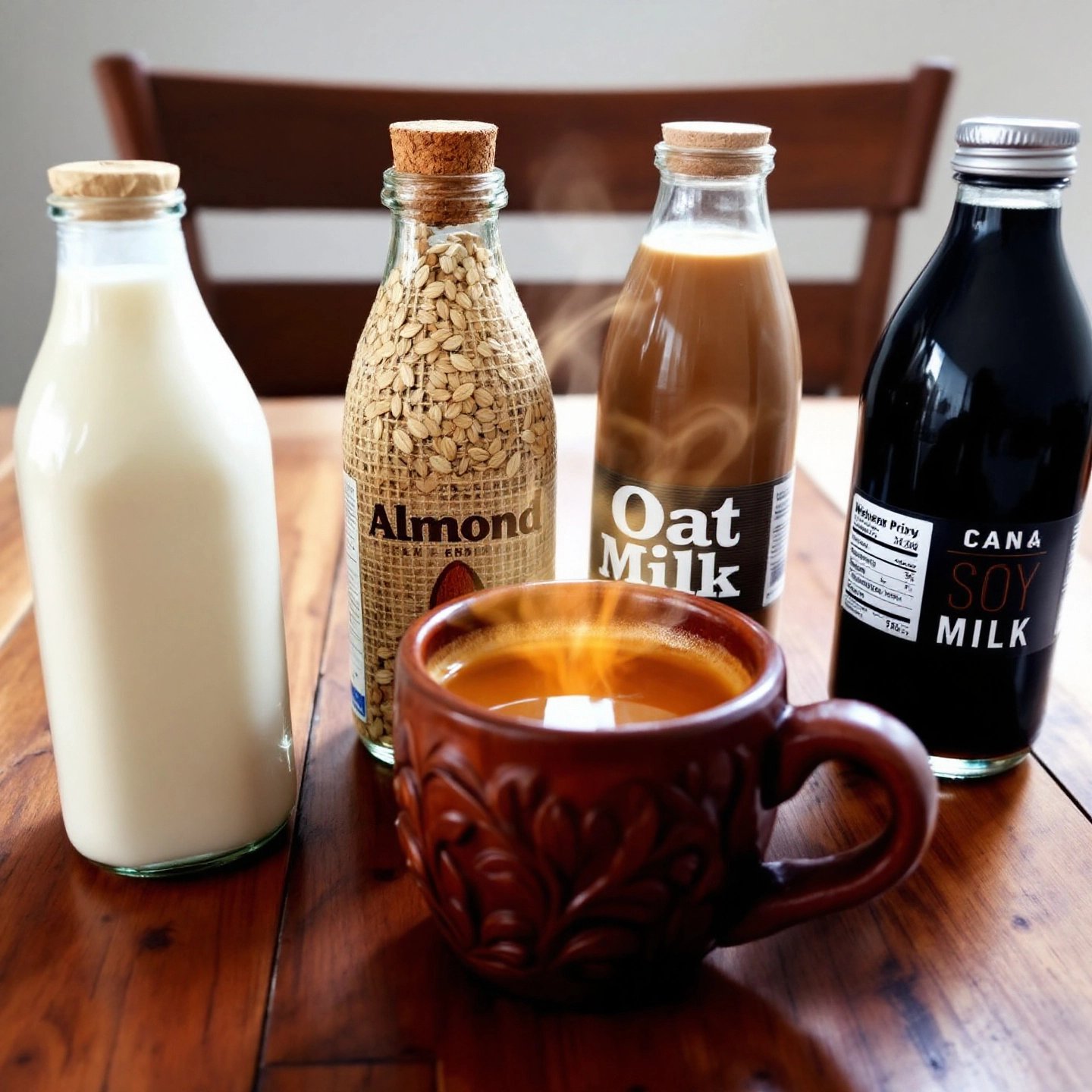Introduction: The Impact of Milk on Your Coffee Experience
Choosing the right milk for your coffee is more than just a simple preference; it’s a vital component that can transform your daily brew into a delightful experience. The type of milk you select plays a crucial role in determining the taste, texture, and overall enjoyment of your coffee drinks. From the creamy richness of whole milk to the nutty undertones of almond milk, each option brings its unique characteristics to the table, influencing the final flavor profile of your coffee.
Understanding the best milk for coffee taste involves considering various factors such as fat content, protein levels, and even the milk’s origin. Traditional dairy options like whole milk, 2% milk, and skim milk offer different levels of creaminess and sweetness, impacting the mouthfeel and foam quality of your beverage. On the other hand, plant-based alternatives such as oat milk, soy milk, and almond milk are gaining popularity for their unique flavors and environmental benefits.
Each milk option, whether dairy or non-dairy, interacts differently with coffee, affecting not just the taste but also the texture and temperature. As we delve deeper into this guide, we’ll explore how these milk options can enhance or alter your coffee experience, helping you to make an informed choice that suits your taste preferences and dietary needs.

Milk composition impacts coffee’s taste and texture (AI-generated)
Understanding Milk Composition: Fat, Protein, and Flavor
The composition of milk, including its fat, protein, and sugar content, plays a pivotal role in its interaction with coffee, influencing taste, texture, and foam quality. Each component contributes uniquely to the overall coffee experience, making the understanding of milk’s chemistry essential for coffee enthusiasts seeking the best milk for coffee taste.
The Role of Fat in Coffee
Fat is a crucial component that significantly impacts the creaminess and mouthfeel of your coffee. Whole milk, with a fat content of about 3.25-3.5%, offers a rich, velvety texture that enhances the coffee’s flavor profile. This fat content melts during steaming, creating a silky consistency that many coffee lovers find irresistible. However, while fat adds richness, it can also mask some of the coffee’s more delicate flavors, which is why some prefer lower-fat options like 2% milk or skim milk.
Protein: The Backbone of Foam
Protein in milk, primarily caseins and whey proteins, is essential for creating stable foam, a key element in many coffee drinks like lattes and cappuccinos. Proteins form a network that traps air introduced during steaming, resulting in microfoam that provides a creamy, smooth texture. Higher protein content, typically found in whole milk, supports better foam stability, making it a preferred choice for those looking to achieve barista-quality froth at home. Skim milk, despite its lower fat content, can also produce good foam due to its relatively high protein levels, but it lacks the creamy mouthfeel provided by higher-fat options.
Sugar and Its Sweet Influence
Milk contains lactose, a natural sugar that contributes to its sweetness. When milk is steamed, the heat enhances its sweetness, complementing the coffee’s natural flavors and reducing bitterness. While whole milk offers a balance of sweetness and creaminess, skim milk, with lower fat content, allows the sweetness to shine more prominently, making it a suitable choice for those who prefer a lighter coffee with a sweeter profile.
Understanding these components helps in selecting the right milk for your coffee, balancing richness, sweetness, and foam quality to suit your personal taste preferences. As we explore further, we’ll delve into specific dairy options and their distinct impacts on your coffee experience.
Dairy Milk Options: From Whole to Skim
When it comes to enhancing the flavor and texture of your coffee, dairy milk remains a popular choice for many coffee enthusiasts. Each type of dairy milk offers a unique set of characteristics that can significantly influence your coffee experience. Let’s explore the various options, from whole milk to skim milk, to help you find the best dairy milk for coffee.
Whole Milk: The Creamy Classic
Whole milk is often hailed as the quintessential choice for coffee drinks like lattes and cappuccinos. With a fat content of approximately 3.25-3.5%, whole milk provides a rich, creamy texture that complements the bold flavors of coffee. This higher fat content not only enhances the mouthfeel but also contributes to superior foam quality, making it ideal for creating velvety microfoam. The balance of sweetness and creaminess in whole milk allows it to mellow the coffee’s acidity, resulting in a well-rounded flavor profile.
2% and 1% Milk: A Balanced Approach
For those seeking a middle ground between richness and calorie content, 2% and 1% milk offer a viable alternative. These reduced-fat options retain some of the creaminess of whole milk but with fewer calories and less fat. While 2% milk maintains a decent level of creaminess and foam stability, 1% milk begins to lose some of these qualities, resulting in a lighter texture and slightly less body. However, both options still provide a pleasant taste and texture, making them suitable for everyday coffee drinks.
Skim Milk: Light and Sweet
Skim milk, with its minimal fat content, is the lightest option available. Despite lacking the creaminess of whole milk, skim milk holds its own in terms of sweetness due to its higher lactose content. This makes it a popular choice for those who prefer a lighter coffee experience with a hint of natural sweetness. Additionally, skim milk can produce a dense, dry foam, allowing espresso flavors to shine through more distinctly. However, its thin body might not satisfy those who enjoy a richer mouthfeel.
In conclusion, the choice between these dairy milk options depends largely on personal preferences regarding taste, texture, and nutritional considerations. Whole milk remains a favorite for its rich texture and foam quality, while reduced-fat and skim options cater to those mindful of calorie and fat intake. As we continue our exploration, we’ll delve into the exciting world of plant-based milk alternatives, offering even more ways to customize your coffee experience.

Plant-based milks offer diverse flavors and benefits (AI-generated)
Plant-Based Alternatives: A Growing Trend in Coffee Culture
The world of coffee has witnessed a significant shift towards plant-based milk alternatives, driven by both health-conscious consumers and environmental advocates. These non-dairy options have become staples in coffee shops and kitchens alike, offering a diverse range of flavors and textures that cater to various dietary preferences and ethical considerations. Among these, soy milk, almond milk, oat milk, and coconut milk stand out as popular choices for coffee enthusiasts seeking the best non-dairy milk for coffee.
Soy Milk: A Protein-Packed Classic
Soy milk has long been a favorite among plant-based milk drinkers, thanks to its high protein content, which mimics the foaming properties of dairy milk. Its slightly sweet and creamy texture pairs well with coffee, though some may notice a subtle bean-like aftertaste. Soy milk’s ability to create a stable foam makes it a reliable choice for lattes and cappuccinos, offering a satisfying alternative to traditional dairy.
Almond Milk: Nutty and Versatile
Almond milk is another popular option, known for its light, nutty flavor. It is a low-calorie choice that can add a unique twist to your coffee. However, its lower protein content can make it challenging to achieve the same foam quality as dairy milk, often resulting in a more delicate froth. Those who enjoy a hint of nuttiness in their coffee may find almond milk to be a delightful addition, although it may not suit everyone’s taste.
Oat Milk: The Barista’s Favorite
Oat milk has rapidly gained popularity in coffee culture due to its creamy texture and neutral flavor, making it an ideal companion for coffee. It is often regarded as the best non-dairy milk for coffee, particularly for those who appreciate a smooth, rich mouthfeel. Oat milk’s ability to create a thick, stable foam is highly valued by baristas, allowing for impressive latte art and a luxurious coffee experience. Its environmental benefits, such as lower water usage and reduced greenhouse gas emissions compared to dairy, further enhance its appeal among eco-conscious consumers. For more insights into oat milk’s rise in the coffee world, check out this comprehensive guide.
Coconut Milk: Exotic and Creamy
Coconut milk offers an exotic flavor profile that can add a tropical twist to your coffee. Its natural sweetness and creamy texture can complement the coffee’s bitterness, though its lower protein content often results in less stable foam. While it may not be the top choice for those seeking frothy cappuccinos, coconut milk is perfect for those who enjoy a hint of coconut flavor in their brew.
As the demand for plant-based options continues to grow, these alternatives not only provide diverse flavor profiles but also align with ethical and environmental values. Choosing the right plant-based milk can enhance your coffee experience, whether you’re seeking a creamy texture, unique flavor, or a sustainable choice. For those interested in making their own plant-based milk, exploring the top plant milk makers of 2025 can provide convenience and eco-friendly options. Visit our guide to plant milk makers for more information.
Barista-Specific Milk Products: Designed for Coffee Perfection
For those passionate about creating the perfect cup of coffee, barista-specific milk products offer an exciting opportunity to enhance your brew. These specially formulated milks, available in both dairy and plant-based varieties, are designed to achieve superior foam, stability, and flavor when mixed with coffee. By understanding the unique properties of these products, home baristas can elevate their coffee-making skills to new heights.
What Makes Barista Milk Special?
Barista-specific milk products are crafted with a higher fat content and additional stabilizers compared to regular milk, which helps mimic the rich, creamy texture of traditional dairy milk. This composition is crucial for producing the smooth, velvety foam that is essential for latte art and other coffee creations. According to Tasting Table, many of these products include added oils and gums to enhance viscosity and foam stability, providing a consistent texture that is ideal for coffee beverages.
Popular Barista Milk Brands
Several brands have emerged as leaders in the barista milk market, each offering unique features tailored to coffee enthusiasts. For instance, Oatly Barista Edition Oatmilk is renowned for its creamy texture and ability to produce a thick, velvety foam that closely resembles that of dairy milk. Its neutral flavor profile makes it a favorite among baristas and coffee drinkers alike.
Another standout is Minor Figures Barista Oat, available in both organic and non-organic versions. While the organic version provides a creamier taste, both options are formulated to enhance the coffee experience with their balanced flavor and moderate foam production.
For those preferring nut-based options, Milkadamia Barista Latte Da offers a unique macadamia nut base, providing a subtle nutty flavor and moderate creaminess. Although its foaming capabilities may not match those of oat-based options, it remains a popular choice for its distinctive taste.
Benefits for Home Baristas
Using barista-specific milk products can significantly enhance the home coffee-making experience. These products are engineered to replicate the qualities of professional-grade coffee shop beverages, allowing home baristas to achieve impressive results with ease. The enhanced foam stability and flavor consistency of barista milks make them ideal for experimenting with latte art and perfecting coffee recipes.
Moreover, the availability of both dairy and plant-based barista milks ensures that there is an option for every preference and dietary need. Whether you are aiming for the rich creaminess of dairy or the environmental benefits of plant-based alternatives, barista-specific milks offer a versatile solution for crafting your ideal coffee drink.
As we continue our exploration of milk options, understanding the nuances of barista-specific products can open new avenues for coffee creativity and enjoyment. Next, we will delve into the techniques for achieving the perfect milk temperature and frothing methods to further enhance your coffee experience.

Master milk frothing for perfect coffee foam (AI-generated)
Milk Temperature and Frothing Techniques for Perfect Coffee
Achieving the perfect coffee drink is an art that extends beyond the choice of milk; it involves mastering the temperature and frothing techniques that bring out the best in your brew. Understanding the ideal milk temperature and frothing methods is essential for enhancing the taste, texture, and visual appeal of your coffee creations.
Ideal Milk Temperature: Striking the Perfect Balance
The temperature of your milk plays a crucial role in determining the final taste and texture of your coffee. According to the Specialty Coffee Association, the recommended milk temperature for coffee drinks like cappuccinos and lattes is between 55-65°C (139-149°F). This range ensures that the milk is warm enough to enhance sweetness and flavor without scalding, which can introduce unpleasant tastes and aromas.
Heating milk beyond 70°C (158°F) can lead to a burnt taste and affect the milk’s ability to foam properly. Conversely, milk that is too cold may not froth well and can result in a drink that is flat and lacking in depth. By maintaining the ideal temperature, you preserve the natural sweetness of the milk and achieve a smooth, creamy consistency that complements your coffee.
Frothing Techniques: Creating the Perfect Foam
Frothing milk involves introducing air to create a microfoam that adds texture and enhances the visual appeal of coffee drinks. The key to successful frothing lies in the technique and the type of milk used. Here are some tips for frothing both dairy and plant-based milks:
Dairy Milk Frothing Tips
- Use fresh, cold milk to start. This helps in creating a denser foam.
- Position the steam wand just below the milk’s surface and turn it on full power. Listen for a high-pitched sound, which indicates the correct position.
- As the milk expands, lower the jug to keep the wand at the surface, then tilt the jug slightly to create a whirlpool effect, breaking down larger bubbles for a smoother foam.
- Stop steaming when the milk reaches 60°C (140°F), allowing the final temperature to stabilize between 65-70°C (149-158°F).
Plant-Based Milk Frothing Tips
- Choose plant-based milks specifically formulated for barista use, as they often have added stabilizers to improve frothing.
- Oat milk is a popular choice for its ability to create a thick, stable foam similar to dairy milk.
- Almond and soy milk can also be frothed successfully, though they may require more practice to achieve the desired consistency.
- Use the same technique as with dairy milk, adjusting the steam wand position and jug angle to suit the milk’s unique properties.
Mastering these frothing techniques and temperature controls will elevate your coffee-making skills, allowing you to create professional-quality beverages at home. As we move forward, understanding these foundational skills will prepare you for exploring the health considerations of different milk options, ensuring that your choice aligns with both taste and dietary needs.
Health Considerations: Choosing the Right Milk for Your Diet
When selecting the best milk for coffee, health considerations play a pivotal role in determining the most suitable choice for your dietary needs. Each type of milk, whether dairy or plant-based, offers a distinct nutritional profile that can impact your health goals, from managing calorie intake to addressing specific dietary restrictions.
Nutritional Profiles of Dairy and Non-Dairy Milks
Dairy milks, such as whole, 2%, and skim milk, vary significantly in their calorie, fat, and protein content. Whole milk, with its rich fat content, is often favored for its creamy texture but is higher in calories compared to reduced-fat or skim options. Skim milk, on the other hand, offers a low-calorie alternative with minimal fat, making it a suitable choice for those seeking to reduce calorie intake while still enjoying a hint of natural sweetness.
For those with lactose intolerance or dairy allergies, plant-based milks present a viable alternative. Options like almond milk are not only lactose-free but also low in calories and sugar, making them an attractive choice for health-conscious individuals. Almond milk, for instance, is noted for its low-calorie and low-sugar content, providing essential nutrients such as calcium and vitamin D without the added sugars found in some dairy products (La Vita Dolce Cafe).
Exploring Low-Fat and Lactose-Free Options
For those aiming to reduce fat intake, skim milk and certain plant-based milks like almond and coconut milk offer low-fat alternatives. Skim milk provides high protein content without the added fat, while almond milk is a popular choice for its low-fat and zero-sugar profile. Coconut milk, although slightly higher in fat than almond milk, is also a lactose-free option that can cater to specific dietary needs.
Lactose-free dairy milk is another option for individuals who wish to enjoy the benefits of cow’s milk without the discomfort of lactose. These milks retain the nutritional benefits of traditional dairy, such as protein and calcium, while eliminating lactose, making them suitable for those with lactose intolerance.
Health Benefits of Plant-Based Milks
Plant-based milks, such as oat and soy milk, offer additional health benefits that may appeal to those looking to incorporate more nutrients into their diet. Oat milk, for example, is praised for its creamy texture and is often fortified with vitamins and minerals, including vitamin B12 and calcium, making it a nutritious choice for coffee lovers (Urnex).
Soy milk, rich in protein, provides a plant-based alternative that closely mimics the protein content of cow’s milk, making it an excellent choice for those seeking to maintain or increase their protein intake. Additionally, soy milk is often fortified with essential nutrients, such as vitamin D and calcium, supporting overall health and wellness.
Ultimately, the healthiest milk for coffee depends on individual dietary needs and preferences. By understanding the nutritional profiles and health benefits of various milk options, coffee enthusiasts can make informed choices that align with their health goals, ensuring that every cup of coffee is both delicious and nourishing. As we conclude our exploration of milk options, we’ll summarize the key points and encourage you to personalize your coffee experience to find the perfect match for your taste and dietary needs.
Conclusion: Personalizing Your Perfect Coffee Experience
Throughout this guide, we’ve explored a wide array of milk options, each offering unique characteristics that can enhance your coffee experience. From the creamy richness of whole milk to the nutty undertones of almond milk, and the growing popularity of oat milk in coffee shops, the choices are vast and varied. The ‘best’ milk for coffee is ultimately a matter of personal taste preferences, dietary needs, and the specific type of coffee drink you enjoy.
Experimentation is key to discovering your ideal coffee-milk combination. Whether you prefer the traditional creaminess of dairy or the nuanced flavors of plant-based alternatives, trying different options will help you find the perfect match for your palate. As you experiment, consider the impact of milk composition on taste, texture, and foam quality, as well as the nutritional benefits and potential dietary restrictions associated with each type.
Plant-based milk alternatives are not only a reflection of evolving consumer preferences but also a testament to the increasing awareness of health and environmental benefits. Oat milk, for instance, is celebrated for its creamy texture and low environmental impact, making it a popular choice among eco-conscious coffee lovers. For those interested in a more personalized and eco-friendly approach, making homemade plant-based milk can be a rewarding endeavor. Investing in a plant milk maker offers convenience and allows you to tailor the flavor and texture to your liking. Explore the top plant milk makers of 2025 for an eco-friendly way to create your own milk at home by visiting our guide to plant milk makers.
Ultimately, personalizing your coffee experience is about balancing taste, health, and sustainability. By understanding the diverse milk options available and their respective benefits, you can create a coffee experience that is uniquely yours, one that aligns with your lifestyle and values. So, embrace the journey of discovery and enjoy the rich, flavorful world of coffee enhanced by your perfect milk choice.
Frequently Asked Questions
1. What type of milk is best in coffee?
Whole milk is often recommended for lattes and cappuccinos due to its balance of fats and proteins, providing a rich texture and smooth microfoam.
2. Is almond or oat milk better in coffee?
Oat milk is preferred for its creamy texture and ability to froth well, making it ideal for coffee drinks, while almond milk offers a nutty flavor and lighter texture.
3. What is the healthiest milk for coffee?
Skim milk and almond milk are healthier options due to their low-calorie content, while oat milk provides additional nutrients like fiber and B vitamins.
4. How does milk composition affect coffee taste?
Milk’s fat, protein, and sugar content influence its creaminess, foam quality, and sweetness, impacting the overall coffee flavor and texture.
5. What are the benefits of using plant-based milk in coffee?
Plant-based milks like oat and almond offer unique flavors, lower calories, and environmental benefits, making them popular choices for health-conscious coffee drinkers.
